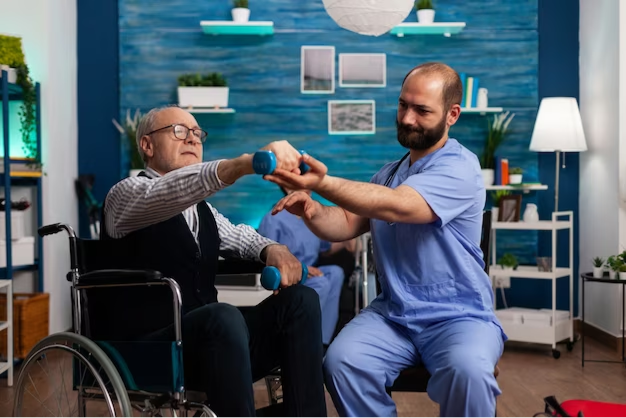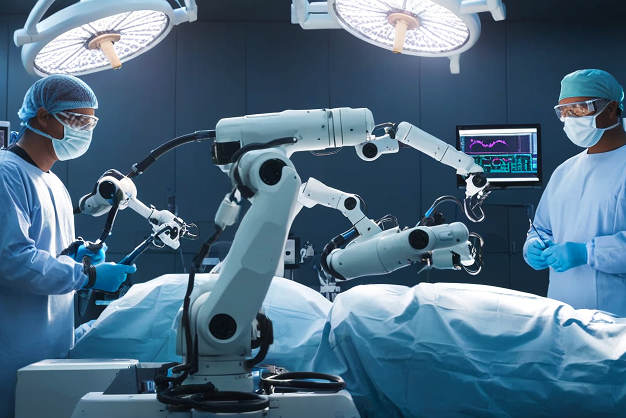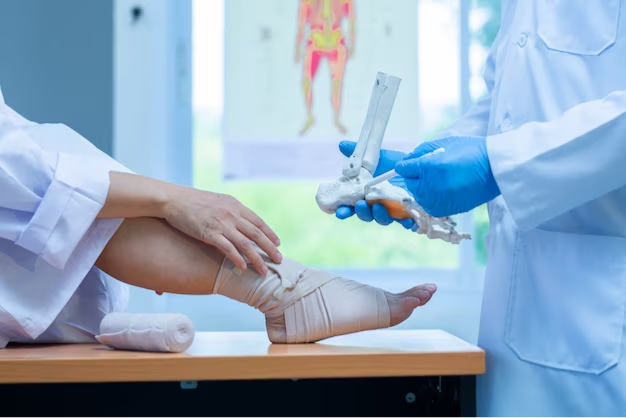
Orthopaedics, Joint Replacement and Arthroscopy
Aging Gracefully: Orthopedic Care for Seniors
December 2023
Orthopaedics, Joint Replacement and Arthroscopy

Author: Dr. Alex Muttathupadom
MBBS, D Orth, DNB Orth, MNAMS, Fellowship in Robotic and Advanced Joint Replacement: Consultant - Orthopaedics
Total knee replacement (TKR) is a surgical procedure that replaces damaged knee joints with artificial ones. In recent years, robotic-assisted TKR has emerged as a promising advancement in orthopedic surgery, offering several advantages over traditional techniques. Following the National and international trend, Kerala too has joined the robotic race. However, most patients and relatives, when given an option for Robot assisted joint replacement, reply-"I trust my doctor more than a robot to take care of my knees. For a relatively new technology, it's natural to have a few questions and concerns.
Part of the answer is common to robotic and conventional surgeries. Two major consequences of arthritis are pain and deformity. A successful surgery aims at alleviating both these issues. Depending on the pattern of the wear and tear of cartilage, the limb may be bowed outwards (Varus), inwards (Valgus), forwards (flexion deformity), or backwards (recurvatum). These deformities may occur in isolation or in combination, Correcting the deformity is the major challenge in any joint replacement surgery. A joint surgeon would vouch that even though replacing joints is part of his daily job, no two joints are the same as far as extend or pattern of the deformity is concerned. Correcting such a wide spectrum of deformities with a limited instrumentation of conventional surgery is the biggest challenge a joint replacement surgeon faces. Presence of situations like an old fracture, presence of metal implants, sequelae of child hood conditions and infections will further complicate the surgery.
The robot becomes a very handy tool in planning, calculating and executing the surgery in such scenarios by individualizing surgical plan to each patient, making use of patient specific instrumentation possible and making use of alternate strategies to achieve deformity correction.
No, they aren't. We are talking about only orthopedic robots here. They aren't all the same. But they all require data to be fed into, and they help in planning, doing the calculations involved and executing the surgery in a more precise way. If the difference between a Robotic and Conventional joint replacement is to be explained in a single word, the word must be "precision".
Some robots require a 3d CT of the patients' knee or hip to be entered into the system well ahead of the surgery. These image dependent robots then help in creating a surgical plan, including the sizes of the implants, positioning of components and possible adjustments depending on the deformities and associated conditions. In short, the surgeon is empowered to conduct a virtual surgery even before going into the operating room. The findings in CT are then cross checked with the native anatomy of the patient during the surgery. They use a robotic arm to prepare the bone surface. The arm is enabled with safety checks like haptic boundaries which makes sure the sharp instruments don't go any further than required.
And then there are image - independent robots who don't require a 3D CT. They capture the anatomy after opening the joint - meaning pre-operative planning is almost similar to conventional surgeries there. They also may have robotic arm, but may not be equipped with haptic boundaries, compromising on the safety levels.
This is another Frequent question a Robotic joint surgeon faces every day. The Surgeon is vey much in the Operating Room, entering data, processing the surgical plan, modifying the angles and calculations till it makes the crooked painful joints a straight painless one. He holds the hands (robotic Arm) and guides it throughout the procedure. In short, the surgeon's brains and hands do all the work, assisted by robot.
Pain will be significantly lesser than a conventional surgery, but there will be wounds even though the tissue handling, is much lesser. In the various studies in which the author took part in a high volume Robotic joint Replacement center, immediate post-operative pain is significantly lesser in Robotic surgery patient walks earlier and goes home faster in a Robotic joint replacement.
Our Orthopedic team handles a huge number of surgeries including Polytrauma, Spine, pelvi - acetabular fractures, Arthroscopy and Sports injuries. Our joint Replacement team has fellowship trained surgeons who are exclusively trained in Robotic and Advanced joint Replacement.
The CARITAS Orthobot is an image dependent system with a robotic arm with multiple safety check point. It is controlled by the surgeon throughout the procedure. The added advantage it offers is precision to the level of millimeters. It can be used in total and partial knee replacements and total hip replacements.

Orthopaedics, Joint Replacement and Arthroscopy
December 2023

Orthopaedics, Joint Replacement and Arthroscopy
December 2023

Orthopaedics, Joint Replacement and Arthroscopy
December 2023